The Banaue Rice Terraces, a UNESCO World Heritage Site, is a must-visit destination for its rich culture and history of the Ifugao people. This site offers an opportunity to engage with the traditions of the Ifugao people.
The best time to visit the Banaue Rice Terraces is from April to May or October to November, when the vibrant green landscapes create perfect photo opportunities.
Stunning spots like Tappiya Falls offer engaging hikes for travelers.
The Banaue Rice Terraces are located approximately 9-12 hours by bus from Manila. To get the most out of your visit, planning is essential.
Travelers can immerse themselves in traditional practices and breathtaking views, such as learning about Ifugao farming techniques and the history of the rice terraces.
Overview of Banaue Rice Terraces
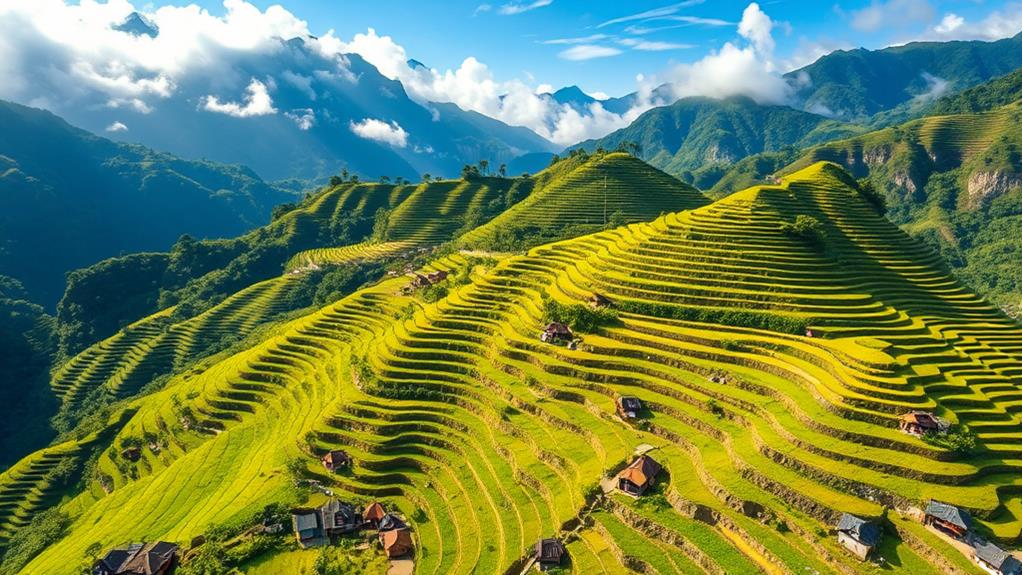
The Banaue Rice Terraces are a remarkable ancient agricultural system. Recognized as a UNESCO World Heritage Site, these terraces showcase the ingenuity of traditional farming techniques crafted by the Ifugao people over 2,000 years ago.
The terraces cover approximately 10,360 square kilometers, creating a stunning landscape that changes with the seasons.
The best times to visit the Banaue Rice Terraces are from April to May and October to November. During these months, the terraces are lush and green, offering fantastic photo opportunities and a deeper appreciation for this cultural symbol of the Ifugao people's heritage.
The vibrant life and colors of the rice fields during these periods allow for a more immersive experience.
Environmental challenges threaten the Banaue Rice Terraces. Urban migration and climate change are significant concerns that impact the preservation of this agricultural wonder.
Understanding these issues can enhance your experience, as local initiatives work tirelessly to address them.
To support these efforts, consider hiring local guides who can share insights about the terraces' history and significance, ensuring your visit is both educational and unforgettable.
History of the Ifugao People
The Ifugao people have lived in the mountains of Northern Luzon for over 2,000 years, developing a rich cultural heritage closely tied to their rice farming practices. Their culture has been intricately woven with rice farming, with the Banaue Rice Terraces serving as a prime example of this connection.
The Banaue Rice Terraces, often referred to as the "Eighth Wonder of the World," demonstrate the Ifugao people's advanced engineering skills. These terraces were carved into the mountainsides using traditional tools and manual labor. The terraces' sophisticated irrigation system channels water from the mountain forests to the fields, ensuring sustainable farming that has fed generations of Ifugao people.
Rice farming is deeply intertwined with Ifugao culture, with rituals and community life closely tied to the harvest. The importance of rice farming is emphasized in their identity, with many community activities centered around the harvest. For example, the Ifugao people celebrate the harvest with festivals and rituals, highlighting the significance of rice farming in their daily lives.
Despite the historical significance of the Ifugao culture and farming techniques, they face challenges from urban migration and modernity. Preservation efforts are underway to maintain their unique heritage, including initiatives to document and protect their traditional practices.
Best Time to Visit
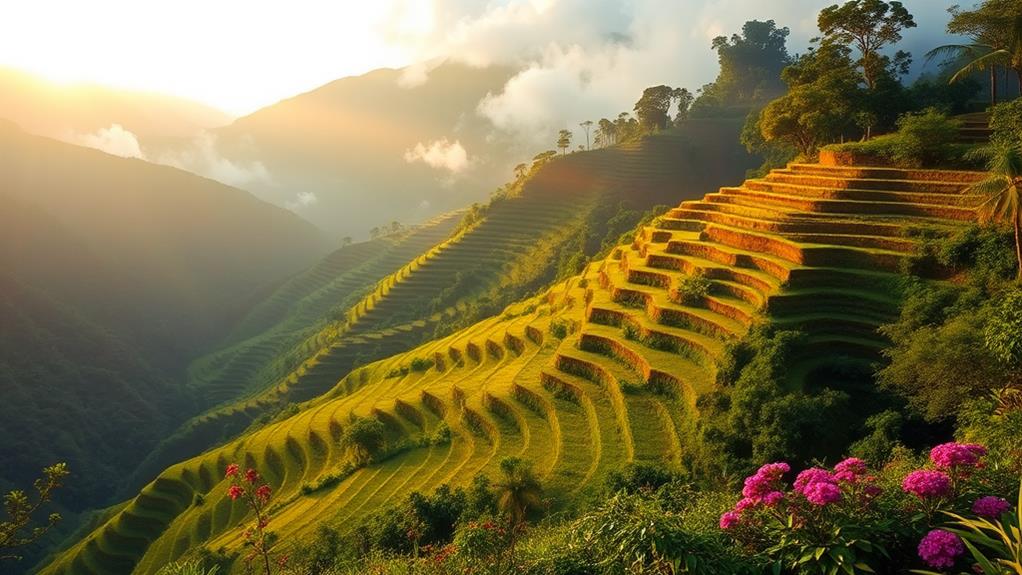
The best time to visit the Banaue Rice Terraces is from April to May and October to November. These months showcase the terraces in their most vibrant greenery, ideal for photography and outdoor activities.
The pleasant weather during these periods allows for exploration without the worry of rain or mud.
If you're interested in witnessing the rice harvesting season, plan your visit for June or December. This provides a unique opportunity to see the terraces in a different light, highlighting the hard work of the Ifugao people.
However, be aware that June to September is the rainy season, bringing high risks of landslides and challenging hiking conditions, making it best to avoid these months for your safety.
Prioritize hiking safety by planning your visit around the dry season. By choosing the right time, you'll immerse yourself in the stunning landscapes of the Banaue Rice Terraces, creating unforgettable memories.
How to Get to Banaue
Traveling to Banaue from Manila takes 9 to 12 hours by bus. The Ohayami Bus Transit operates nightly services, making it a convenient option for this journey.
Travelers should expect to navigate winding mountain roads that lead deeper into the heart of the Philippines.
Travel time from Baguio to Banaue is approximately 3 hours by bus. Multiple departures occur throughout the day.
An alternative is to take a jeepney from Sagada to Bontoc and then board a local bus to Banaue.
Booking bus tickets in advance is recommended, especially during peak seasons. Seats fill up quickly, and advance booking ensures availability.
Additionally, travelers should monitor weather forecasts, as the rainy season can cause landslides and delays.
Transportation Options
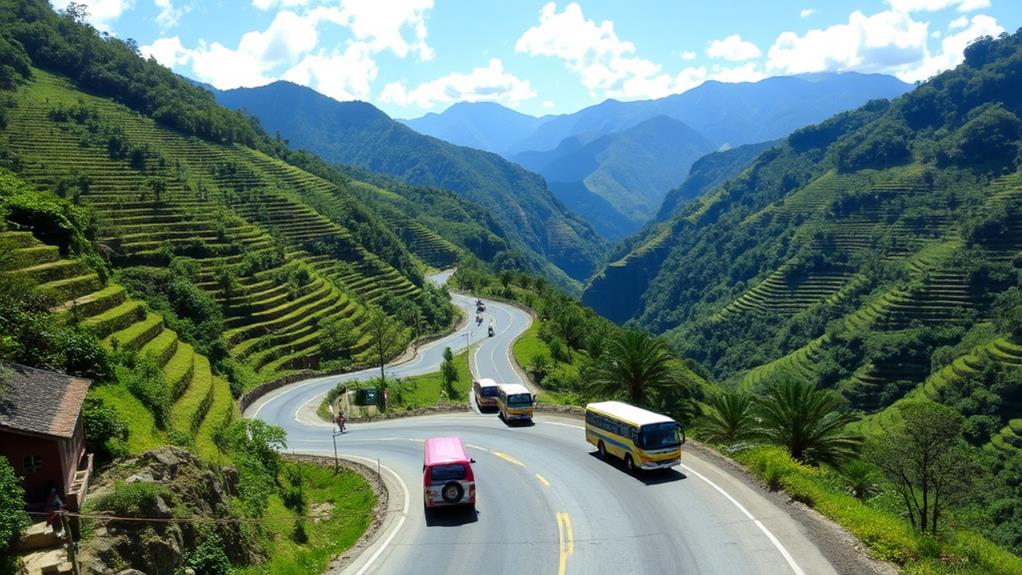
Reaching Banaue from Manila
To get to Banaue from Manila, taking an overnight bus is the most common option. The journey takes about 9-12 hours, with Ohayami Transit being a popular choice. Tickets cost around PHP 450-600 (USD 9-12), making it an affordable choice for budget travelers.
Alternative Route from Baguio
If you're coming from Baguio, several bus companies offer daily departures, taking roughly 3 hours to reach Banaue.
Local Transportation in Banaue
Once you arrive in Banaue, local transport options include jeepneys and tricycles. Jeepneys are a fun and social way to get around, while tricycles provide convenient rides to nearby attractions, including the rice terraces and hot springs.
Important Travel Tip
Carry enough cash, as transportation costs must be settled in cash, and ATMs are scarce in Banaue and the surrounding areas.
Tours and Activities
Explore the Best of Banaue Through Guided Tours and Activities
Banaue offers a variety of tours and activities that highlight the town's stunning rice terraces and vibrant local culture. Adventure packages like the 8-Day North Luzon Adventure and the 3-Day Sagada Tour include guided tours to the Banaue Rice Terraces. These tours allow you to engage with Ifugao traditions and delve into their rich heritage.
Discover Breathtaking Views at Tappiyah Falls
For breathtaking views, visit Tappiyah Falls, a popular hiking destination with trails that wind through lush landscapes. To prepare for the hike, pack proper hiking gear and a lunch to enjoy amidst nature's splendor. This allows you to capture the beauty of the terraces and immerse yourself in the surroundings.
Experience Local Cuisine with Stunning Views
After a day of exploration, treat yourself to local dining options like Sanafe Lodge or Banaue Homestay. These restaurants offer delicious local cuisine while providing stunning views of the surroundings.
This combination of food and scenery allows you to satisfy your adventurous spirit and deepen your appreciation for the culture and traditions of the Ifugao people.
Hiking and Nature Adventures
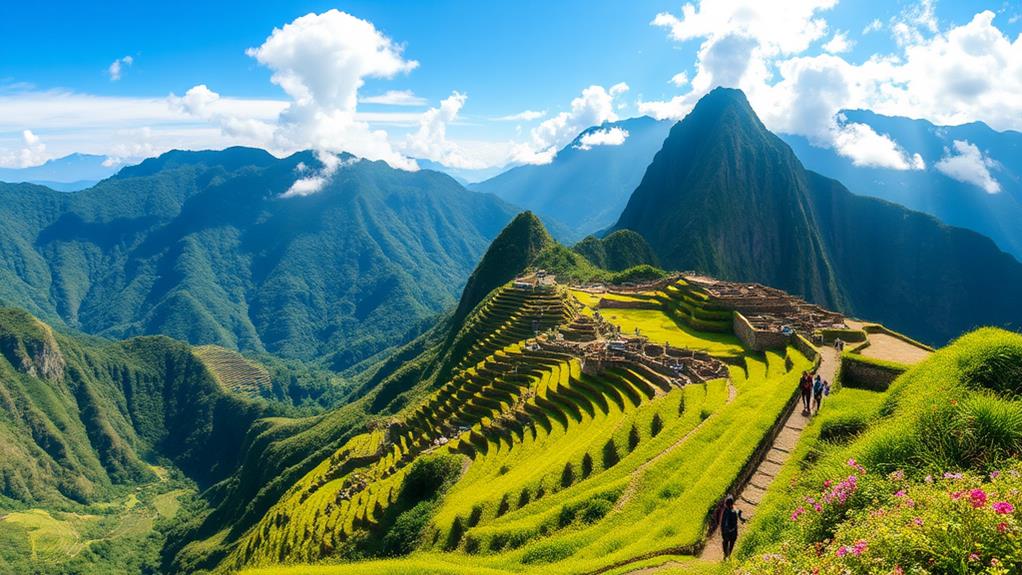
Hiking the trails of Banaue offers an immersive adventure through the region's landscapes and culture.
The hike to Tappiya Falls in Batad is approximately 30 minutes each way. This trek features a challenging descent and ascent, followed by a refreshing swim in the waterfall's cool waters.
For a more leisurely experience, the Hapao Rice Terraces are accessible via a one-hour walk, offering stunning views of the terraces.
Visitors can also relax in nearby hot springs.
Cultural Experiences
The Banaue Rice Terraces are a UNESCO World Heritage site that showcases Ifugao culture and agricultural techniques. The terraces have been in use for over 2,000 years, demonstrating the Ifugao people's expertise in farming and land management.
These rice fields aren't only a testament to Ifugao ingenuity but also a reflection of the community's strong spiritual connection to the land.
Participating in Ifugao thanksgiving celebrations is a great way to experience local traditions. These celebrations highlight the community's agricultural roots and spiritual beliefs. During these events, you can observe and participate in traditional dances, music, and food preparations that bring the community together.
Sampling authentic Ifugao dishes is a culinary adventure that showcases the community's use of locally sourced ingredients. These meals are prepared using traditional methods and ingredients such as wild boar, fish, and native vegetables.
By eating at homestays and local eateries, you can taste the unique flavors of Ifugao cuisine and learn about the stories behind each dish.
Learning about ancient rice farming rituals from local farmers is an immersive experience. Local farmers are eager to share their knowledge of sustainable farming methods that have been passed down through generations.
By learning from these farmers, you can gain a deeper understanding of Ifugao culture and the importance of preserving traditional farming practices.
Tam-an Village is a great place to find traditional textiles and crafts. The village is known for its vibrant textiles and crafts that reflect the artistic expressions of the Ifugao people.
Accommodation Choices
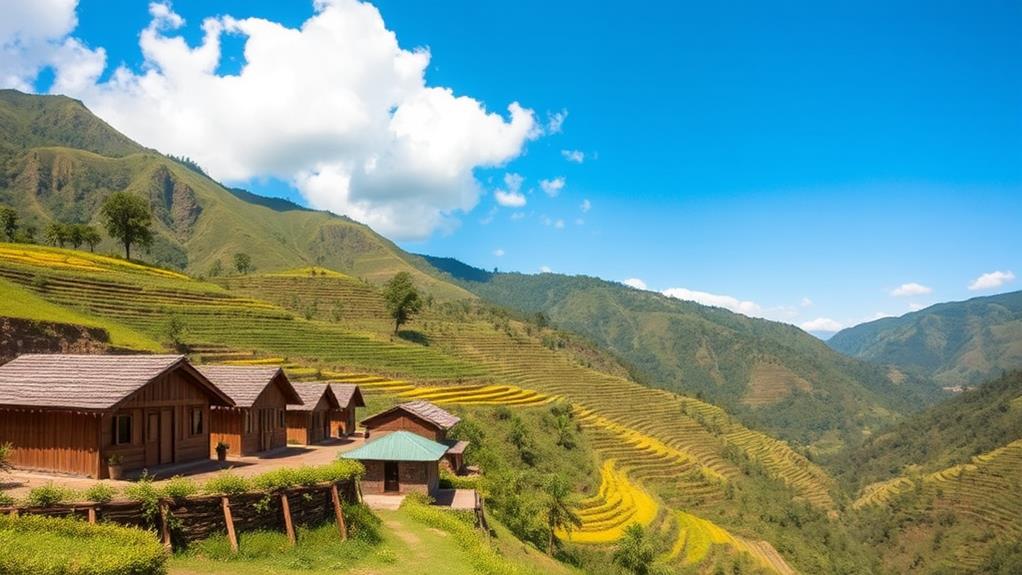
Finding the Right Place to Stay in Banaue
When visiting Banaue, finding the right accommodation can greatly enhance your experience of the region.
For budget-conscious travelers, Banaue Homestay and Ramon's Home Stay are two affordable options that offer cozy atmospheres and authentic experiences. These establishments provide opportunities to immerse in local customs, with Ramon's Home Stay featuring traditional huts and engaging cultural storytelling sessions.
Unique Experiences
For those seeking unique experiences, Batad Top View Homestay is a recommended option. Located a 20-minute hike away, this homestay offers stunning views of the Amphitheater Rice Terraces and provides an authentic taste of Ifugao life.
Accommodation Features and Availability
Many lodgings in Banaue and Batad emphasize simplicity, with basic amenities and limited hot water.
A genuine connection to the area is the primary focus, giving travelers an immersive experience of the local culture.
When traveling during peak seasons, reservations are recommended to secure your spot, although some accommodations can be found upon arrival.
Dining Options
Banaue offers various dining options to cater to different tastes and budgets. For those seeking a scenic view, Sanafe Lodge is a suitable choice, offering outdoor dining with a view of the rice terraces and serving homemade meals made from fresh local ingredients.
Native Village Inn is another option for a romantic setting, overlooking the Hapao Terraces and serving curries and authentic Filipino dishes.
Dining options in Banaue also cater to different atmospheres. For a lively atmosphere, Las Vegas Lodge features live music and a diverse menu with affordable meal options.
For budget-friendly options, Banaue Homestay provides home-cooked meals at around PHP 100 (about USD 2).
7th Heavens Café is a cozy spot for those seeking a relaxed atmosphere while enjoying local cuisine.
Dining in Banaue can be both affordable and enjoyable. With various options available, visitors can choose the setting and cuisine that suits their preferences and budget, ensuring a memorable dining experience.
Key Attractions Nearby
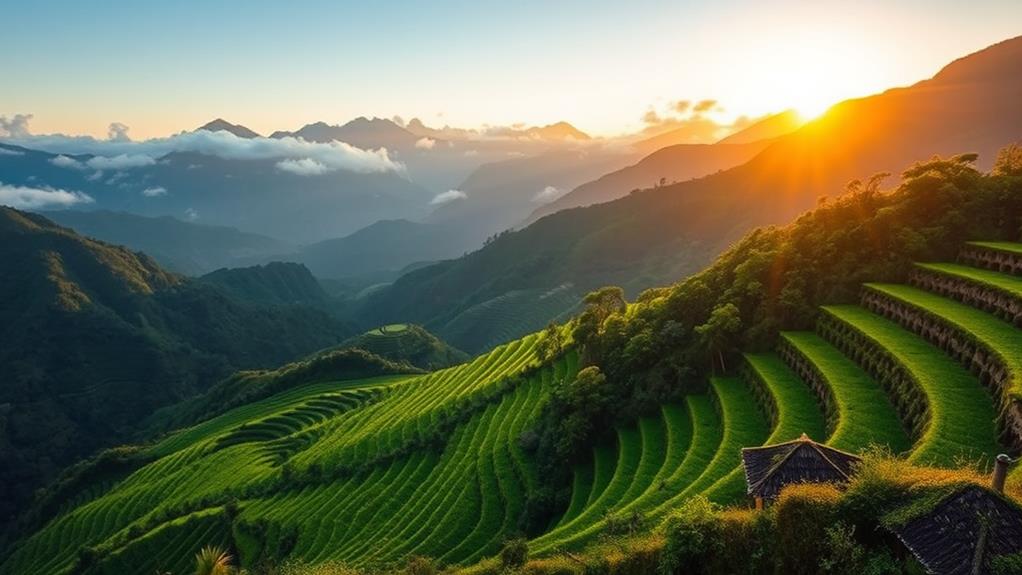
The Ifugao region offers numerous breathtaking attractions near Banaue.
Several attractions showcase the beauty of the region and provide a glimpse into its rich culture and stunning landscapes.
| Attraction | Description |
|---|---|
| Batad Rice Terraces | A UNESCO World Heritage Site with steep, stunning terraces and the nearby Tappiya Falls. |
| Hapao Rice Terraces | These wider and less steep terraces lead to natural hot springs. |
| Mayoyao Rice Terraces | Remote yet breathtaking, these terraces offer stunning views without the crowds. |
| Tam-an Village | A village with local crafts and traditional Ifugao life. |
To unwind, visit the Bogyah Hot Springs near the Hapao Rice Terraces.
These free hot springs offer a rejuvenating experience.
Practical Travel Tips
When to Visit the Banaue Rice Terraces
The best time to visit the Banaue Rice Terraces is between April to May or October to November. During these periods, the terraces are lush and the weather is pleasant, making it ideal for sightseeing and outdoor activities.
Getting to the Banaue Rice Terraces
Traveling to the Banaue Rice Terraces from Manila takes approximately 9-12 hours by bus. Ohayami Bus Transit offers nightly departures, providing a comfortable overnight journey. This bus ride is a convenient option for travelers.
Accommodation Options
For accommodation, consider Banaue Homestay or Bogah Homestay. These options offer stunning views and affordable meals, allowing travelers to immerse themselves in the local culture.
Local Transportation
Jeepneys and tricycles are easily accessible for exploring nearby attractions, such as the hot springs in Hapao. Using local transportation provides an authentic experience and allows travelers to interact with the locals.
Packing and Preparation
When visiting the Banaue Rice Terraces, it's essential to pack hiking gear for excursions to breathtaking sites like Tappiyah Falls.
Bringing packed lunches will keep travelers fueled during hikes, allowing them to focus on their surroundings.
Additionally, travel insurance is necessary to cover any unforeseen circumstances.
Itinerary Suggestions
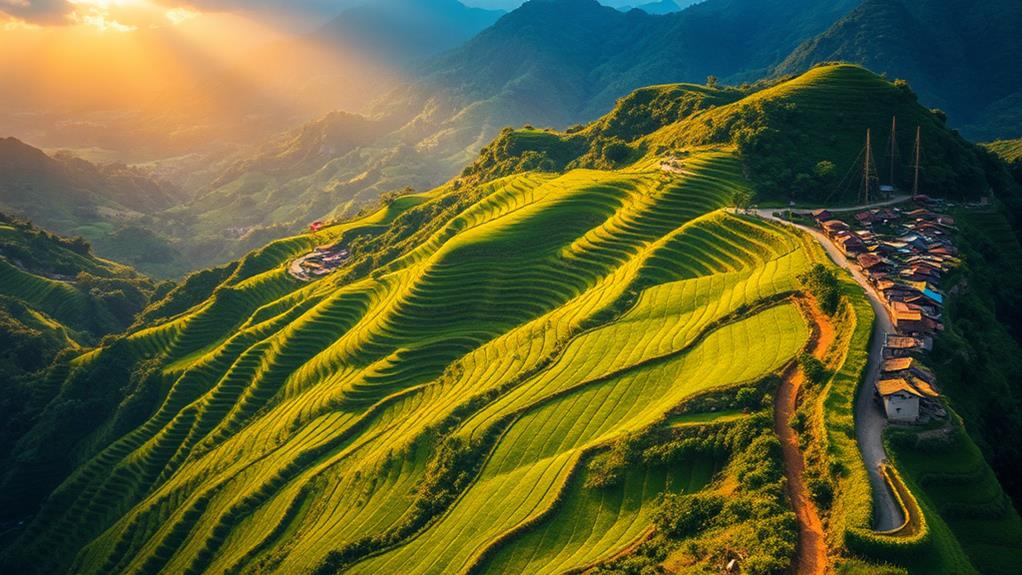
Best Time to Plan Your Adventure Around the Banaue Rice Terraces: Upon settling into your accommodations and taking in the breathtaking views, plan your adventure around the Banaue Rice Terraces. This destination offers a blend of culture and nature.
Day 1: Arrival in Banaue: Arrive in Banaue in the morning by taking an overnight bus from Manila. This allows you to start exploring the iconic rice terraces immediately.
Day 2: Exploring the Rice Terraces and Local Culture: Spend the day hiking to Tappiya Falls and visiting Batad Rice Terraces. Engage with local Ifugao farmers to gain a deeper understanding of their culture.
Day 3: Relaxation and Local Crafts: Take a leisurely walk at Hapao Rice Terraces and soak in the nearby hot springs. Visit Tam-an Village to explore local crafts.
Extended Stay Option: Consider staying longer to experience Mayoyao Rice Terraces, a less-touristed area offering scenic views and cultural richness.
What Makes the Banaue Rice Terraces a Must-See Destination Compared to the Enchanted River?
The Banaue Rice Terraces captivate visitors with their ancient, hand-carved landscapes that stretch across the mountains, offering a glimpse into the ingenuity of Filipino heritage. Unlike the azure waters highlighted in enchanted river travel tips, the terraces provide a serene, cultural journey, showcasing breathtaking views and a connection to centuries-old traditions.
Sustainable Tourism Practices
Sustainable Tourism in Banaue Supports Local Communities and the Environment
Visiting the Ifugao rice terraces in Banaue embodies a profound respect for the region's rich cultural and agricultural heritage. By staying in eco-friendly accommodations, you directly support local families and contribute to sustainable living.
For example, some accommodations in Banaue use solar power, reduce water waste, and promote recycling.
Engaging with local guides is essential to understanding the cultural significance of the rice terraces. These guides promote responsible hiking practices and help you navigate trails with minimal environmental impact.
For instance, guides educate visitors on the importance of staying on designated trails and not littering.
Participating in conservation efforts is also crucial. You can contribute by respecting local customs, minimizing waste, and supporting initiatives like the Ifugao Rice Terraces Rehabilitation and Preservation Act.
This act emphasizes sustainable farming techniques, such as crop rotation and organic farming.
Questions and Answers
How Many Days Do You Need in Banaue?
At least two days are needed in Banaue to experience the best activities. Two days allows time to explore the stunning trails and take in breathtaking views, such as the famous Banaue Rice Terraces. It also provides enough time to visit nearby attractions like the Tappiya Waterfall and the Banaue Museum, which offers insight into the local culture.
Is Banaue Rice Terraces Worth Visiting?
The Banaue Rice Terraces are worth visiting. They offer breathtaking views of the Ifugao Mountains and the surrounding landscape. The site is also rich in cultural significance, with over 2,000 years of history and traditional farming practices.
Visitors can engage in trekking trails that allow them to explore the area and appreciate its natural beauty. The trails offer varying levels of difficulty, catering to different types of hikers.
When visiting the Banaue Rice Terraces, you can also experience local cuisine, which often features traditional dishes made from locally-grown ingredients. Additionally, the site provides numerous opportunities to capture stunning photographs, thanks to its picturesque landscape and unique architecture.
How Long Is the Drive From Manila to Banaue Rice Terraces?
The drive from Manila to Banaue takes about 9 to 12 hours. This duration may vary due to factors such as weather and road conditions. To make the most of your trip, plan sightseeing stops along the way to experience the local culture and cuisine.
When to Visit Batad?
The best time to visit Batad is between April to May or October to November.
This period offers ideal conditions for exploring the area. Vibrant terraces are a prominent feature during these months, as the lush green landscapes create a picturesque scenery. Additionally, local accommodations and cultural festivals are more accessible during this time, allowing visitors to immerse themselves in the local culture.
Weather conditions and transportation methods are also more favorable between April to May or October to November. The weather is generally mild, making it easier to hike and explore the area. Furthermore, hiking trails are more accessible, providing stunning photography opportunities.